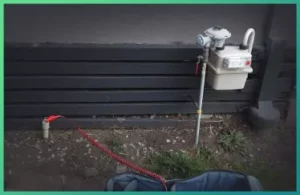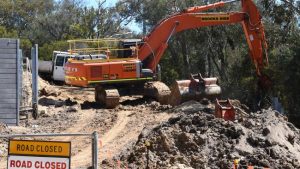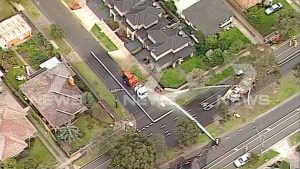Dial Before You Dig

At Geelong Cable Locations we seem to get a lot of questions relating to Dial Before You Dig (DBYD). So I thought it might be helpful to dedicate a full blog post to just DBYD and try to defuse some of the myths, explain how DBYD actually works and give a few tips that can help you out.
First things first: Dial Before You Dig is not a competitor of Geelong Cable Locations—in fact quite the opposite. We are actually a member of DBYD itself, under the non-asset owner category and we work hand in hand with DBYD to achieve the common goals of protecting buried assets and reducing the amount of cables and pipes that get damaged each year.
A summary of the differences between Geelong Cable Locations and Dial Before You Dig
Dial Before You Dig is a free service: you tell them where you’re going to be working and they’ll send out plans of the underground assets known to be in that area.
Whereas, if you call Geelong Cable Locations, we’ll charge you a fee to come out to your site and show you where the underground cables and pipes are buried.
Either way, we’re both trying to ensure you don’t damage the pipes and cables in the works area.
A bit more detail about Dial Before You Dig
In Victoria Dial Before You Dig used to be known as the old ‘Melbourne One Call service’ (for those of you who’ve been around for a while and remember it), in each state they all had there owned ‘One Call’ service and had different names and phone numbers. Then in 1999 they became Dial Before You Dig and went nationwide across Australia and shared one common number, that being 1100. (for the record the creation of Dial Before You Dig, was part of the catalyst that caused the creation of Geelong Cable Locations.
DBYD is a not-for-profit association. It acts as a referral service.
Each state has it own board members who represent different sections of the industry and volunteer to be on the DBYD board for that state. They then employ a manager and a team of employees to run the operations of DBYD in their state.
As we are based in Victoria and only work in Victoria, the remainder of this page refers only to the operations within Victoria state. If you’re reading this and from another state, then please refer to the DBYD website for clarification on how DBYD affects you in your state.
Ok, so now that I have got that part out, let me explain one of the finer details that you really need to be well aware of with DBYD which I personally feel is not explained well enough from Dial Before You Dig themselves.
As mentioned above, DBYD is a referral service. You call them (or go to their website), tell them the address where you’re working and then select the area of works.
They then pass on your details to every single asset holder known to have underground assets within that area and who are members of Dial Before You Dig.
Now, this is something we feel Dial Before You Dig don’t explain fully to members of the public and those who don’t use the service every day: It is NOT compulsory for asset owners to be members of DBYD.
Furthermore, if they are members of DBYD they have to pay DBYD a small fee every time someone submits a DBYD request within an area where they’ve told DBYD they have some underground assets, so that they can inform you there are works going ahead in or near your underground assets.
An example of how DBYD works
Let’s just recap that again.
Let’s say that next week you’re going to be digging at the corner of Collins Street and Swanston Street in the heart of Melbourne, and you jump on the DBYD website and submit an online request for plans of that area.
Dial Before You Dig would then send out your request (which contains your name, email address and the area you’re working in) to all the utility companies who have underground assets there, who are members of DBYD and who’ve told DBYD that their assets are in the Collins Street-Swanston Street area.
As at the time of writing, that means DBYD contacts 12 individual companies: APA Group Networks, Citipower, City of Melbourne, City West Water, Nextgen, Optus, PIPE Networks, Telstra, Verizon, Victrack & Yarra Trams.
Each one of them will get your request and then each of them will individually email you out the plans of their underground assets in that area.
Now the problem—and what a lot of people don’t realise—is that even though you receive 12 different lots of plans from every utility company registered with DBYD for the area, there still may very well be other underground pipes and cables buried in the area you’re going to be working in.
For this particular intersection, that could include other optic fibre providers like NBN or smaller telecommunication companies that have just started up, or private optic fibre lines going from one building to another. (A lot of large organisations with several high-rise office blocks close together will have their own private optic fibre line running just between their own buildings even if they are blocks apart from each other.)
But the obvious omission from the list of asset owners at this particular intersection is VicRoads. There are traffic lights at this intersection. But, because VicRoads is not a member of DBYD, means you won’t receive plans from VicRoads when you make your DBYD request.
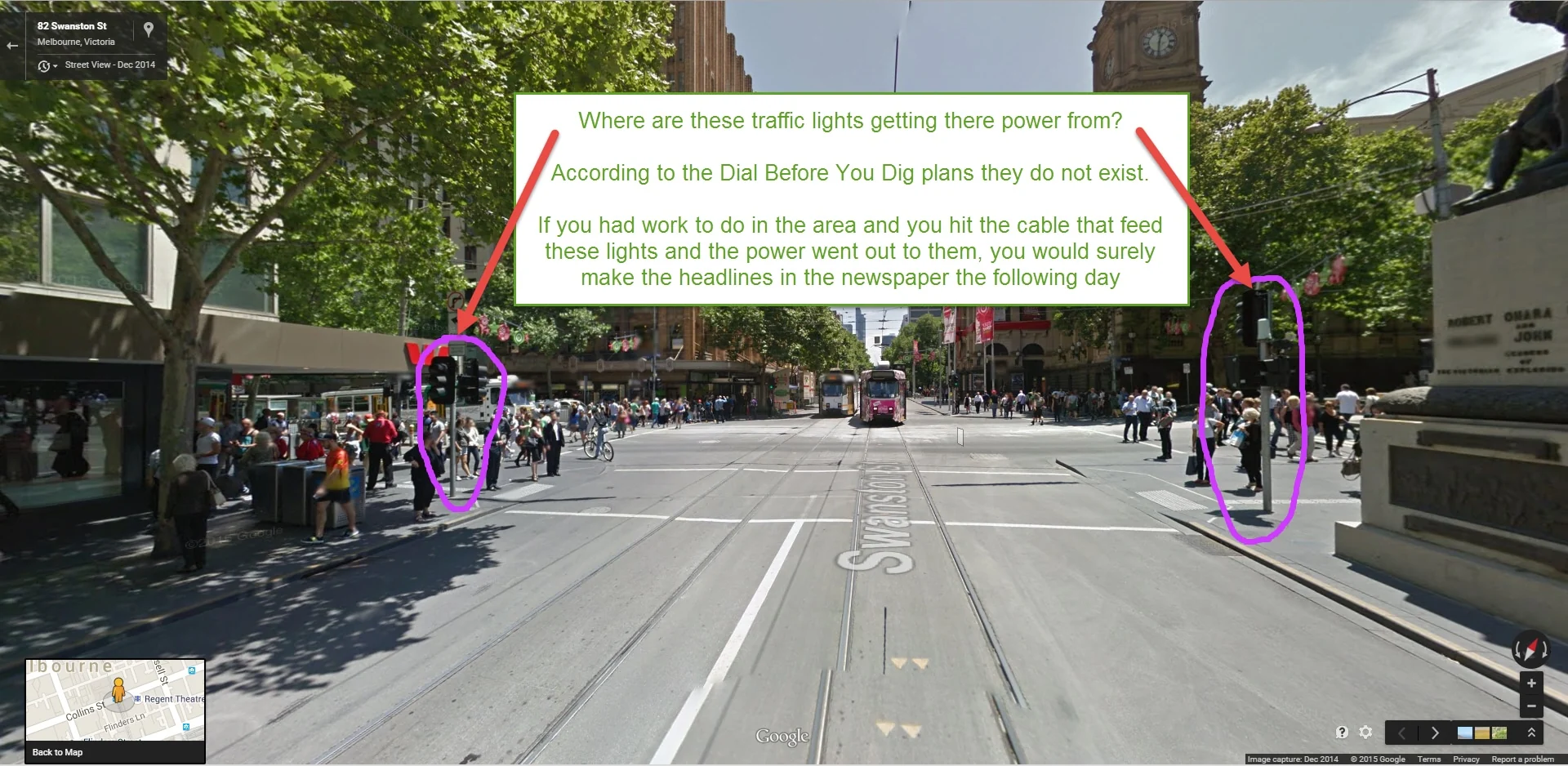
VicRoads is probably the biggest asset owner who is not a member of DBYD, but there are plenty of others—common ones are water authorities, including Coliban Water, South Gippsland Water and Lower Murray Water. And councils are even worse with just under 30 of them not being members of DBYD. Some of them include City of Wyndham, Darebin City Council, Greater Dandenong City, Moorabool Shire Council and City of Greater Bendigo just to name a few.
Now, some of these companies and government authorities are not members of DBYD because they don’t want to pay the fee each time someone makes a DBYD request—even though the fee is generally around $1-2 per request. Some of them object because of the extra man hours it takes them to reply to the 100,000s of requests made each year, even though PelicanCorp (the company that designed and run the DBYD website) have created some excellent automation software so the system can virtually run itself. We suspect there are also a few cases of arrogance where these utility companies and government bodies feel you should have a ‘dig-at-your-own-risk’ attitude and if you do hit their pipes or cables you’ll just have to fix it yourself.
But whatever the reason is, the main take away I want you to remember from this is: Even when you get back all the plans from DBYD, there may still be more underground asset holders who have cables and pipes in the area that you are working in.
Another problem with the Dial Before You Dig plans
That leads us on to the next major point that you need to be aware of: The plans that come back to you from a DBYD request are only a guide and may not have all the assets on them.
Let’s use gas plans as an example. The plans you get back from the gas company will show you where the gas mains are out in the street, what type of pipes they are, what pressure they are, and even when they were installed.
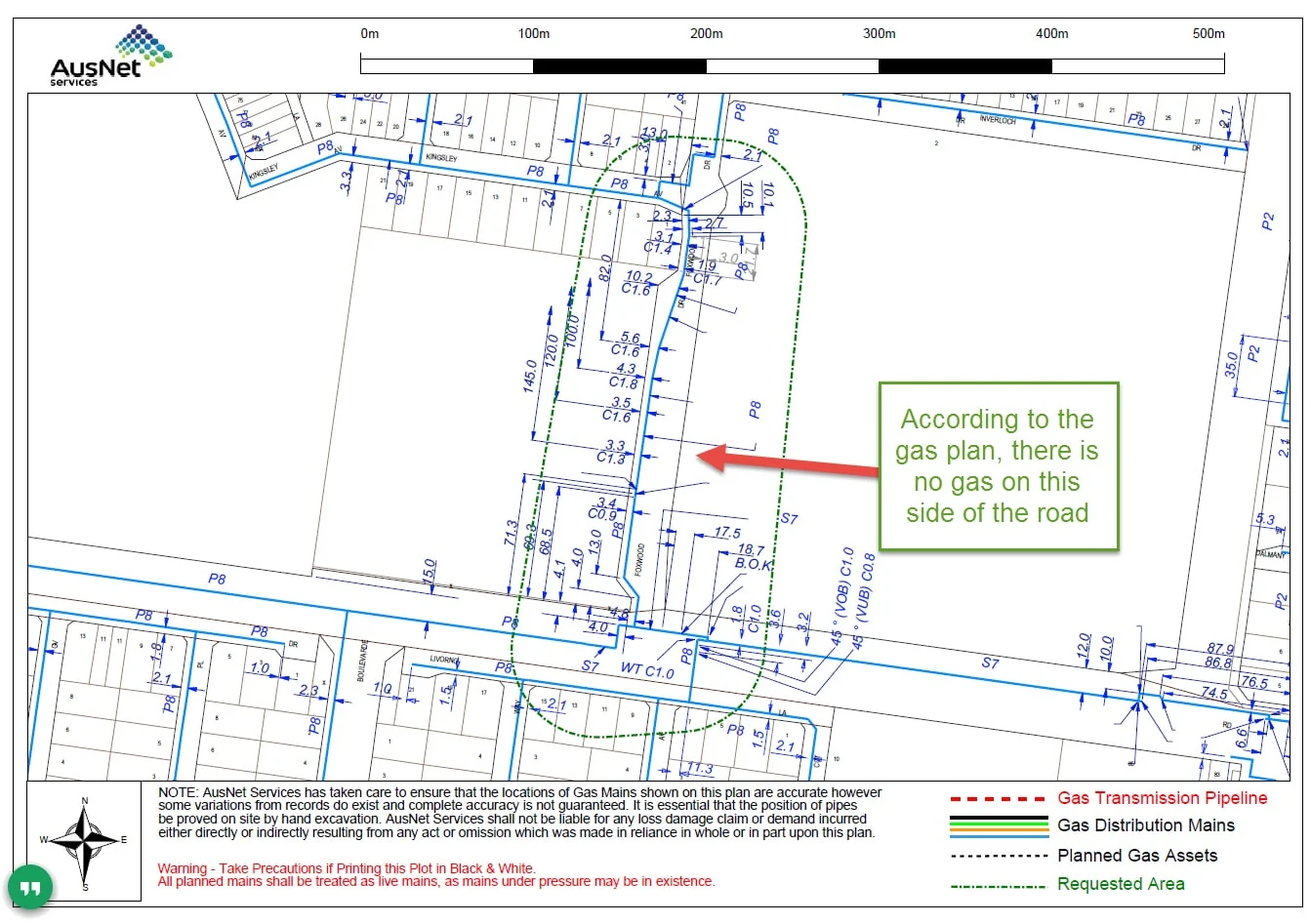
But what they don’t tell you is where the houses along the street get their gas from—in other words, where the gas pipe is that runs from the gas meter next to the house to the gas main in the street.

And to give you another tip: Pipes don’t always run in a dead straight line.
Some plans, like the Telstra ones, don’t even give you an offset. It’s just a schematic drawing to give you a guide to what cables are in the area.
Another tip for you: Most DBYD plans don’t show the depth of the utility on them. And of the handful that do, you need to remember that the depth was taken at the date the cable or pipe in question was installed. If the road has been raised, or if a new garden bed has been placed on top of the area since installation, then the depth of the cable could actually be deeper or shallower than is shown on the plans.
Some other common myths about DBYD
Below we have listed down some of the most common myths that we hear constantly about DBYD;
It’s difficult to request a plan – In fact it’s actually really easy. If you haven’t done it before, there is a full step-by-step guide PDF on the DBYD website. Once you’ve done it a couple of times then you’ll find you will be able to do a new request in a matter of minutes. We probably average about 5 requests each day ourselves, and it generally takes about 40 seconds to do, depending on the internet connection. And if you don’t have internet access, you can still call DBYD during business hours. Their phone number is still the same as it has always been – 1100.
It takes too long to get plans back from them – I recently dedicated a full blog post to just this subject and filmed a video to show how long it takes in real time. Take a look yourself, here is the link to it. If you haven’t done a DBYD request for several years then you’ll be amazed how fast plans comeback these days.
DBYD plans are wrong – I would dare say that we would probably see a lot more DBYD plans than most people. And yes, we do come across a small percentage that are clearly wrong. But as mentioned above the plans are just a guide—that’s all. And there’s also a big difference between a plan that’s completely wrong and a plan showing what is in the area, but just not being to scale. You need to remember some of these plans are more than 50 years old. When they were initially drawn up they were for the company’s internal use only; they were never intended to be handed out to the general public to use. (For the record, the oldest pipe we’ve seen on a DBYD plan and that we’ve actually digitally located was a water main in North Melbourne that was laid in the late 1800’s. And yes, it’s still in use today!)
You don’t need to do a DBYD request because you are working inside private property – Regardless of where you are working, if you are doing any form of excavation you should always do a DBYD request. Keep in mind a large majority of Telstra optic fibre cables that run throughout Australia are actually laid inside private property.
You don’t need to print the plans because you have the DBYD email on your computer – Even if you’ve done all your checks and you’re confident you know where the underground cables are, you still need to have a copy of the DBYD plans onsite. If something goes wrong and a cable or pipe gets cut, then, after making sure everyone is safe the first question the investigators from the utility companies normally ask is to see the DBYD plans. If you only have them back at your office on a computer, then the investigators will classify you as not having DBYD plans at all. These days, with modern technology, you don’t necessarily have to print the plans out on paper, but if you have them on an iPad then they need to be easily accessible to everyone working onsite.
You did a DBYD request 12 months ago, and you know nothing new has being installed underground, so you don’t need to do another one again – Again, if something happens onsite and a cable is cut, the first thing the authorities check is whether your plans are up-to-date. If they are out-dated, then the investigators will classify you as not having current DBYD plans. And this is regardless of whether the service you cut is on the old plans you have or not: If the plans are out-of-date then the investigators consider it the same as having no plans at all. So, my final tip for now: To play it safe, always renew your plans every 30 days. It’s free and only takes a few minutes.
Ok, that is it, I think there is enough info in here to help you out. As I said earlier, I love Dial Before You Dig, I think it is an amazing service and we are lucky to have it so readily available. But if you don’t use it everyday like we do, then hopefully some of these tips have helped you out and you are now a little wiser.
Like always, if I can offer any further assistance, be it about DBYD or about cable locating in general, then please don’t hesitate to contact me.
Regards
Ben

